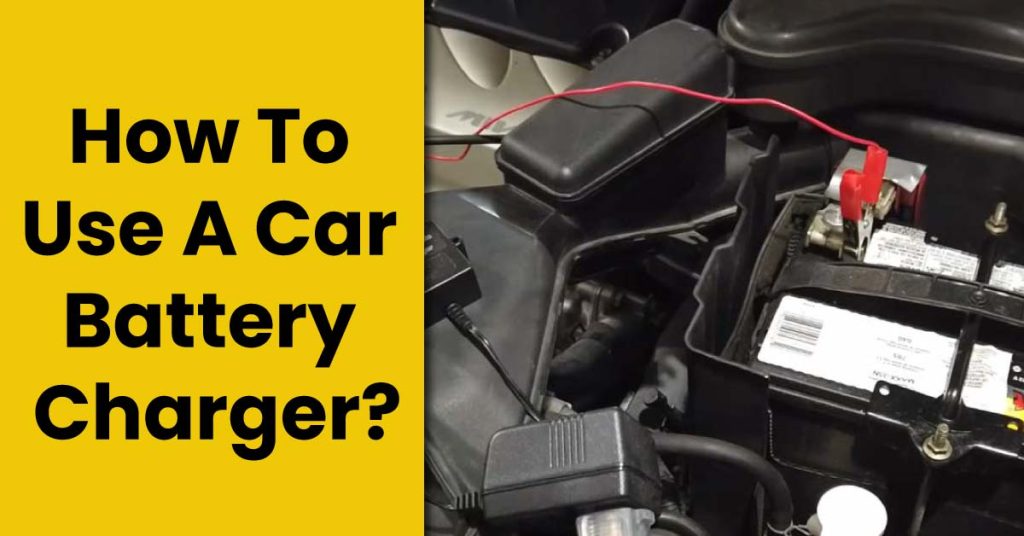How To Use A Car Battery Charger?
A battery of a car contains certain types of chemicals that produce hydrogen gas during its use. As hydrogen gas is volatile and can easily explode under certain conditions, it can be hazardous. A car battery can explode when you try to start the car, by carelessly shorting the terminals while jump-starting. It can even explode when you’re just sitting under a parked car.
To avoid any such incident, it is important to know and everything about how to use a battery charger properly under safe conditions. It is also necessary to know about it because the dead battery is a common problem that occurs especially in cold winter months. If you are finding it difficult to start a car or the battery is dying, you should consider carrying a portable charger in your trunk in order to be safe.
In this article, we’re going to share some of the safest ways of using a battery charger to charge the battery of a car or any other vehicle.
How Does A Battery Charger Work?
All battery chargers have one thing common among them and that is their working ability is only possible in the presence of electric current through batteries for a specific period in hope that the cell inside will hold on to some of the energy passing through them. This is the only point where the similarity between chargers begins and ends.
The cheapest chargers use either constant current or constant voltage and apply that to batteries until you turn their switch off. If you’ll forget to switch it off, batteries will be overcharged and if you plug out the charger very soon, you won’t be able to charge it enough.
Batteries are just like a suitcase, the more you pack in, the harder it will be to anymore and the longer time it will take. To elaborate, consider the process of charging a battery involves reversing the chemical reaction that occurs when it discharges.
In the case of laptop battery, charging and discharging involves shunting lithium ions back and forth from one electrode to another. As the ions carry a positive charge, it is easy to move them to empty electrodes at the start. As they start to build up, it will be harder to pack more of them in.
- Checkout our guide about how to replace a golf cart battery
Overcharging A Battery
The case of overcharging a battery is worse than undercharging. As if the battery is fully charged and the switch isn’t turned off, the battery will have to get rid of the extra energy you’re forcefully feeding into it. This will be compensated by heating the system and building up pressure inside that can make them leak chemicals or gas, rupturing, and even explode.
Time Chargers
There are some sophisticated time chargers that are also available in the market that switch themselves off automatically after a set period. But it won’t be as perfect to prevent overcharging or undercharging because the ideal time varies for all kinds of reasons.
The best chargers work in a very intelligent way by using a microchip-based electronic circuit to find it out how much charge is already stored in the battery.
How To Use A Car Battery Charger

There are the following helpful tips to charge the battery in optimal conditions in a situation where your battery is dying and it needs to be recharged again.
Connecting A Battery Charger:
Before connecting the charger to the battery first, you need to get a charger that is suitable for your battery. After choosing the right charger, connect it to the particular battery. If you’re charging a car’s battery you can do it even if the battery is inside the car or has been removed, both methods are fine.
For making the right connections first attach a positive clamp (red) to the positive post on the battery. There will be a positive post indicator with a + sign on the battery. Then connect the negative clamp (black) to the negative post on the battery.
Setting The Charger:
Now you’ll have to set up the amperes or volts on the charger. Lower amperage will be sufficient if you want a slow trickle charger. In case of a quick attempt to start the car, you will need a battery charger of higher amperage.
Trickle charging is the best option to use if you have enough time as it will charge the battery in a better way.
Plug-In And Charge:
Plugin the charger into the switch and let it do its work. There will be a need of setting a specific time for the charger to work or it may shut off automatically after being fully charged. It won’t be good to move the charger or play with the cord during the process of charging.
Disconnect:
After charging the battery fully, turn off the charger and remove the plug from it. Disconnect the cables in the opposite order in which you attached them first. Remove the negative clamp first and then the positive one.
Your battery should be charged completely before you get ready to go.
Types Of Car Battery Chargers
A basic battery charger includes a rectifier and a transformer to change the mains 110/220 volt by alternating the current to 12 volts direct current and also allows to provide main supply to charging current at a determined rate by the actual state of the battery.
If the condition of the battery is good, the rate or charge will be around 3 to 6 amperes with the help of a normal home charger.
If the lifespan of the battery is about to end, it may not be able to accept any recharging and also won’t be able to hold the charge for a longer period.
In some chargers, there are two charging rates fitted with a high and low switch to deliver 3 or 6 amperes. It will be suitable to give the battery a short overnight boost at 6amperes rather than a longer charge at 3 amperes.
How To hook Up A Car Battery Charger?
It is necessary to follow the instructions inside the manual for the particular battery charger. Before connecting a battery charger in case of a car battery, make sure that the car battery charger is turned off.
Take the positive cable of a car battery and connect it to the positive terminal of the car battery. After establishing this connection, get a negative cable from car battery charger and connect this to the negative terminal of the car battery.
After connecting both cables to the terminal, turn on the charger and set it to the slowest charging rate. When this all will be done set how long you want to charge the car battery.
- Checkout our guide about how to clean the terminals of battery
How Does A Battery Work?
When you turn on the power switch, you give the green light to chemical reactions inside the battery. With the flowing current, cells inside the battery begin to transform themselves in startling but visible completely. The chemicals by which their components are made start rearranging themselves.
Within each cell, there are two electrical terminals where chemical reactions take place while a chemical known as electrolyte separates them. These reactions cause electrons to pump around the circuit the battery is connected that provides power to a flashlight.
In the case of a rechargeable battery, you can make chemical reactions run in reverse using a battery charger. While charging the battery is the opposite of discharging it where discharging gives out energy. The charging process takes in energy and stores it by resetting the battery chemicals to how they were originally present.
Rechargeable batteries degrade over time and then eventually a stage comes where they are no longer willing to store charge anymore. That is the time to throw them or recycle them.
Charging Different Kinds Of Rechargeable Batteries
Different types of rechargeable batteries respond to different types of the charger in separate ways. So, a suitable charger for one particular type of battery may not be good to work with another.
Lithium-Ion Batteries:
Lithium-ion batteries are usually installed in gadgets such as MP3 players, cellphones, digital cameras, and laptops. They have their chargers with automatic sensors to detect when charging is complete and cut off the supply of power to avoid overcharging.
But sometimes, these rechargeable lithium-ion batteries become dangerously unstable with fluctuation in voltage from very high to very low. That’s why they are designed to operate suitably to avoid such situations.
These batteries do not show a memory effect and degrade with time. A common sign of aging is gradual discharge for a time period followed by sudden and completely unexpected cuts out of the gadget.
Nickel-based Batteries:
The oldest and best-known type of rechargeable battery is the Nickel-cadmium battery. These batteries respond in the best way to rapid charging as well as slow trickle charging.
While Nickel-metal hydrides are with newer technology and are similar to nicads but are highly expensive due to their ability to store more charge. These batteries can be fast-charged or trickle-charged.
These batteries are recommended to charge fully before using them for the first time.
Lead-Acid Batteries:
The oldest, biggest, and heaviest rechargeable batteries are lead-acid batteries. They are more familiar to everyone as car batteries but also used in buggies and electric wheelchairs. These are popular because they’re simple, reliable, cheap, and have well-proven technology.
They take a quite long time to charge and are sometimes left under charge. While overcharging can also occur that degrades the battery performance by making the acid stronger and more likely to attack plates.
Matching Batteries To The Charger
The first rule for battery charging is that a charger designed for one kind of charger should be used only for that particular battery and not for any other battery.
You can’t charge a cell phone with a car battery charger but neither should you charge NiMH batteries with a nicad charger.
You don’t need to worry about matching a charger to the battery as each appliance comes with its own specific charger.
The voltage and current a battery require should be marked on the battery pack.
If you want to get rechargeable batteries but are unsure about how to go about matching batteries and chargers, then buy a combined set where you can easily get a charger and battery in the same package.
Tips For Better Battery Life
It is highly recommended by battery experts to condition and recondition your batteries. It means you let discharge the battery substantially before recharging it.
Rechargeable batteries work perfectly when used on a daily basis. Don’t leave them alone in the shed, fully charged or fully discharged for a longer period.
Never overcharge the battery, otherwise, you’ll damage it.
Match charger to the battery such as an NiMH charger should be used only for NiMH batteries with the right voltage and current.
Do not let the battery get too cold or too hot during storage, charging, or usage. The battery can get warm during charging but if it is too hot, it means there’s something wrong.

Alex Black is a seasoned electrical engineer with a remarkable 8-year track record specializing in appliances, generators, and transfer switches. With extensive hands-on experience in the field, Alex possesses a deep understanding of electrical systems and their intricate workings. Throughout their career, Alex has consistently demonstrated expertise in designing, troubleshooting, and maintaining various electrical appliances.
